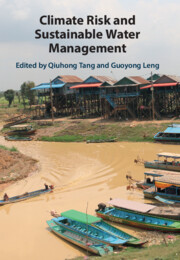Book contents
- Climate Risk and Sustainable Water Management
- Climate Risk and Sustainable Water Management
- Copyright page
- Contents
- Contributors
- Preface
- Acknowledgements
- Part I Water-Related Risks under Climate Change
- 1 Pluvial, Fluvial and Coastal Flood Risks and Sustainable Flood Management in the Pearl River Delta under Climate Change
- 2 Flooding Risk in the Lancang-Mekong River Basin under Global Change
- 3 Spatial Drought Patterns in East Africa
- 4 Assessment of Global Water Erosion Vulnerability under Climate Change
- 5 Water Erosion and Its Controlling Factors in the Anthropocene
- 6 Climate Change Impacts on Saltwater Intrusion into Coastal Aquifers
- Part II Climate Risk to Human and Natural Systems
- Part III Sustainable Water Management under Future Uncertainty
- Index
- References
6 - Climate Change Impacts on Saltwater Intrusion into Coastal Aquifers
from Part I - Water-Related Risks under Climate Change
Published online by Cambridge University Press: 17 March 2022
- Climate Risk and Sustainable Water Management
- Climate Risk and Sustainable Water Management
- Copyright page
- Contents
- Contributors
- Preface
- Acknowledgements
- Part I Water-Related Risks under Climate Change
- 1 Pluvial, Fluvial and Coastal Flood Risks and Sustainable Flood Management in the Pearl River Delta under Climate Change
- 2 Flooding Risk in the Lancang-Mekong River Basin under Global Change
- 3 Spatial Drought Patterns in East Africa
- 4 Assessment of Global Water Erosion Vulnerability under Climate Change
- 5 Water Erosion and Its Controlling Factors in the Anthropocene
- 6 Climate Change Impacts on Saltwater Intrusion into Coastal Aquifers
- Part II Climate Risk to Human and Natural Systems
- Part III Sustainable Water Management under Future Uncertainty
- Index
- References
Summary
Saltwater intrusion into coastal aquifers menace multiple coastal areas globally, degrading groundwater quality, which poses an important threat to freshwater supply for agricultural, industrial and domestic utilization. Groundwater over-exploitation used to be commonly recognized as the principle factor causing saltwater intrusion, while sea-level rise, intensified storm surges and precipitation change have grown to become important drivers of factors inducing saltwater intrusion as well. In the context of exacerbated human activities such as groundwater over-exploitation due to the ever-increasing water demand because of population growth and economic and social development, as well as sea-level rise and increased frequency and intensity of extreme weather events and warmer temperatures and changing precipitation patterns and regimes resulting from climate change, the phenomenon of saltwater intrusion worldwide has been seriously aggravated recently. A deeper understanding of the theories and multiple pathways of saltwater intrusion, the commonly-used methods to investigate the extent of saltwater intrusion, as well as numerical approaches to assess the impacts of anthropogenic activities and climate change on saltwater intrusion in future are of great importance to mitigate its negative effects.
Keywords
- Type
- Chapter
- Information
- Climate Risk and Sustainable Water Management , pp. 110 - 136Publisher: Cambridge University PressPrint publication year: 2022

